There are many philosophies about how people learn. A key principle that underlines most approaches, however, is that:
The learner learns what the learner wants to learn.
Looking back at your own life, can you think of a time when you deliberately set out to learn something? You may have wanted to learn how to drive, touch type, master a skill, solve a problem, lead a team or whatever.
If you wish, try tackling the exercise on this theme. This invites you to do the following things.
Describe a specific time in the past when you set out to learn something.
Describe the specific things you did then – the steps you took – to learn it.
Describe the specific benefits of learning it.
Peter Senge believes that people love to learn. Writing in The Fifth Discipline: The Art and Practice of the Learning Organisation, he explained:
Real learning gets to the heart of what it means to be human. Through learning we re-create ourselves.
Through learning we become able to do something we never were able to do. Through learning we reperceive the world and our relationship to it.
Through learning we extend our capacity to create, to be part of the generative process of life. There is within each of us a deep hunger for this type of learning.
Peter believes that an organisation’s ability to develop calls for creating an environment that encourages its people to learn. Why? This is its only chance to thrive in an increasingly complex world.
People want to learn things that are relevant and rewarding. Let’s explore some examples of where this holds true.
The first stems from New Zealand in the middle of the 20th Century. The second applies to people learning how to develop in today’s fast moving world.
Reaching Out To learn
Sylvia Ashton-Warner was a gifted but complex teacher who worked with Māori children in New Zealand from the 1940s onwards.
Experts flocked to study her methods for helping children to learn to read and write. She produced excellent results, but had the reputation of being somewhat difficult. So what was the secret of her success?
Sylvia believed in organic reading and writing. Learning must be real. It must start from a person’s experience and relate to their world.
Children were then able to learn quickly and, in the process, develop their inner strength. Let’s explore how this worked in practice, starting with an example from her book Teacher.
Bringing learning to life
Sylvia calls the children to attention each morning by playing the first eight notes of Beethoven’s Fifth Symphony.
She asks the class to tackle their work, then invites each child to her in turn. Gay is the first child to come to her desk.
Sylvia asks: “What word do you want today?”
Gay replies: “House.”
Sylvia writes the word on a piece of cardboard. She then asks Gay to trace the word with her finger and say it out loud. Gay ‘owns’ the word, it comes from her guts.
Sylvia makes sure that Gay says the word, sees the word and feels it in her body. She gives Gay the cardboard and asks her to keep her ‘word’ for the day.
Sylvia repeats the process with each child. When the class finishes, she collects all the words on the separate pieces of cardboard.
The next morning Sylvia starts the class by tipping the cardboard words onto the floor. She tells the children:
“Find your word.”
Gay leaps from the chair and rummages in the pile.
“House,” she shouts, “I have found my word.”
Children have two visions, an inner vision and an outer vision, said Sylvia, and it is the inner vision that burns brightest. Gay grasps the word that she spoke from her inner vision.
Sylvia would then ask each child to choose a partner, speak their words and hear their partner’s words. While the children taught each other, she repeated the process of inviting each child to choose their word for the day. They built up what Sylvia called their Key Vocabulary.
What happened if Gay failed to find her word? Sylvia ripped up the piece of cardboard. The word has failed the ‘one look’ test and could not have any great meaning for Gay.
In those days the classrooms often displayed Jack and Jill illustrations to introduce the reading vocabulary to five-year-olds, says Sylvia, but it was a vocabulary chosen by educationalists in Auckland or London.
Gay could only own those words that came from deep within herself. She was more likely to love these words and want to write them on paper.
Shouldn’t these Māori children be learning Oxbridge English? Once they knew the joy of creating their own words, said Sylvia, they would reach out longingly to learn about other cultures. She believed that:
Reaching out for a book must become an organic action.
The same rule applies to many kinds of learning.
The New 3Rs in Education
Today some people talk about the new 3Rs regarding education. Students are more likely to learn if the following conditions are in place.
Relationships
The learner needs to feel safe and have a good relationship with the educator. They are then more able to be open, take risks and dare to try new things.
Relevance
The learner needs to see the relevance of what they are going to learn.
Rigour
The learner can then develop the rigour and resilience that is required to learn new things. It can also be useful to build in time to reflect on the learning and see results.
Good educators create encouraging environments in which people learn how to learn. The students often develop this skill by learning things they find relevant. This also helps them to make good decisions and manage complexity in a fast changing world.
Today there are many educational projects that focus on helping young people to develop what are called 21st Century Skills.
These are often termed as Critical Thinking, Creativity, Collaboration and Communication. These are the skills that employers say they want the people to learn.
Some governments, however, want to force through schooling programmes that emphasise rigour and learn by rote. They forget about the importance of relationships and relevance.
Learning At Work
You will, of course, apply this approach in your own way. Looking at my own work, I have spent much of my life mentoring and running workshops.
The times when this has worked well have often been because I was able to tap into people’s learning agendas. The times when I have hit trouble have been when I did not take this step.
People sometimes do choose to learn certain skills, however, even if they do not feel immediately attracted to doing so. Why? They see the big picture.
They see how learning the skill is relevant to enabling them to reach certain goals. People therefore choose to learn the skill in order to achieve future success.
During my twenties, for example, I decided to learn to touch type. This meant a two hour round trip into London every day for half hour lessons over a period of two weeks.
Looking ahead, I aimed to spend much of my life writing. Watching the moving light go from key to key was not great. I chose to do it, however, because the long term benefits would be rewarding.
This approach can be worth bearing in mind when running workshops for people in organisations. People may prefer to be somewhere else, other than on the workshop.
So it is important to position the benefits for people. They can then actively choose to give their best on the session.
How to make this happen? Imagine you are running such a workshop. You will probably meet with the key stakeholders ahead of time and ask some of the following questions.
What are the goals of the session? What are the key themes it would be useful to focus on?
What are the concrete things that you and other people would like to take away from the session? What are the real results you want to achieve? What is the picture of success?
Who are the people who will be coming to the session? What is happening in their world? What are some of the challenges they face? What are the specific results they want to deliver – or must deliver – in their work?
What are their strengths? What are the specific areas in which people deliver As, rather than Bs or Cs? How can they build on these strengths? What are the things they need to learn to manage the consequences of any weaknesses?
What are the kinds of examples they will be able to relate to? What are their learning styles? What are the overall Dos and Don’ts for relating to these people?
What are the actual words you want people to be saying after the session? What do you want them to be thinking, feeling and then doing? What for you – and for them – will make it a successful session?
Bearing their answers in mind, play back your understanding regarding the goals for the session. Make sure everybody is agreed on the desired outcomes. You will aim to make the workshop relevant and rewarding for the participants.
When starting the actual session, it will be important to make clear working contracts with people. You may say something like:
Welcome to the session.
Today the aim is to provide practical tools you can use to continue to achieve success.
Bearing in mind the overall organisation’s goals – and the challenges you face in your work – some of the topics we aim to explore today are:
How to …
How to …
How to …
My role is to provide an encouraging environment and practical tools that work. The role I would like you to take is to encourage each other and also apply the tools in your own way.
Bearing in mind what I have outlined, are there any other topics you would like us to explore?
If appropriate, you can also add other topics that will contribute towards people achieving success. People often say, however:
“That sounds enough to be going on with. If we do those things, then we will be well on our way.”
Good educators make sure that the learning relates to people’s personal or professional goals. They ensure that people make a conscious decision to choose to learn the topic during the session.
Let’s return to your own life and work. Looking to the future, are there any things you want to learn?
If you wish, try tackling the exercise on this theme. This invites you to do the following things.
Describe a specific thing that you would like to learn in the future.
Describe the specific things you can do – the steps you can take – to learn it.
Describe the specific benefits of learning this thing.


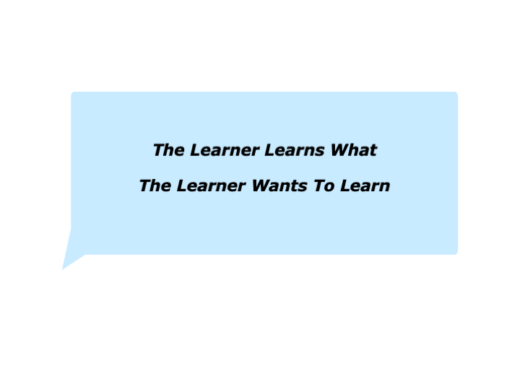
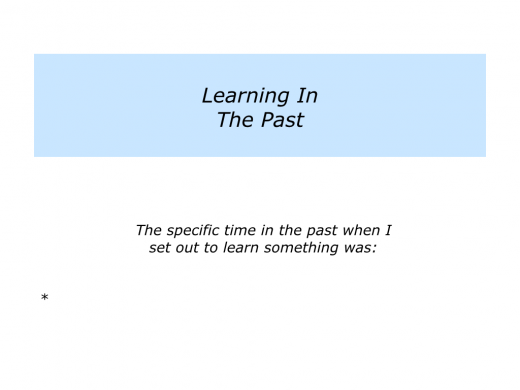
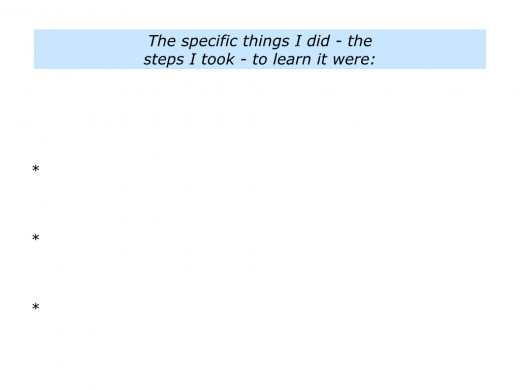
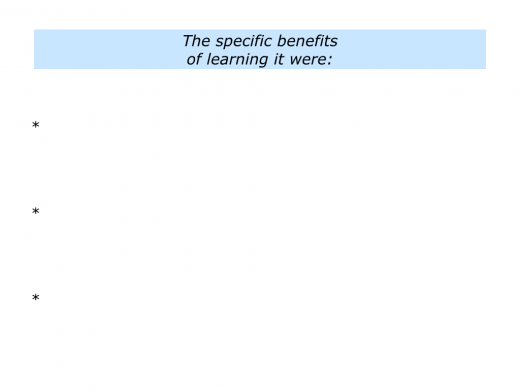
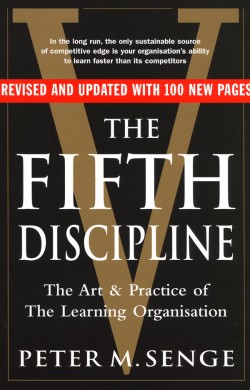
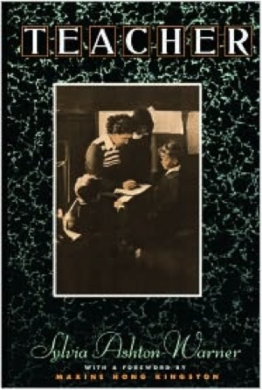
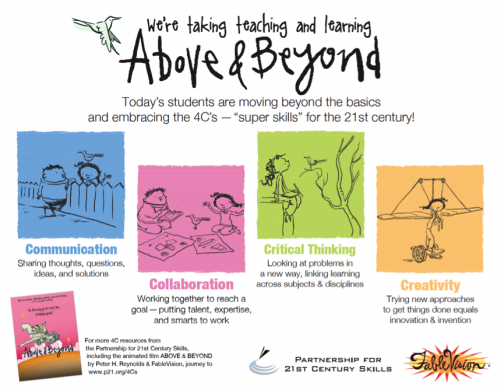
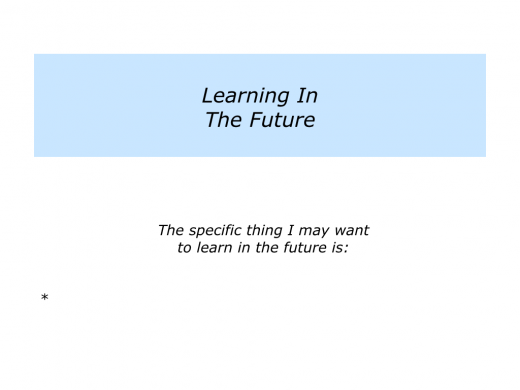
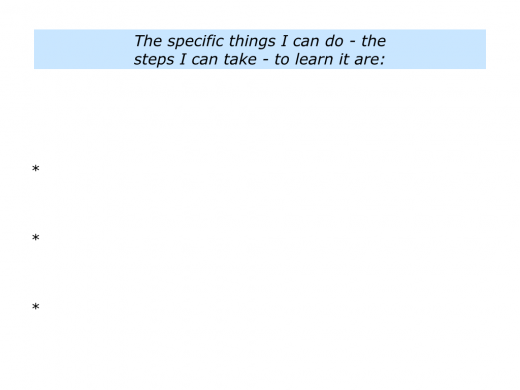
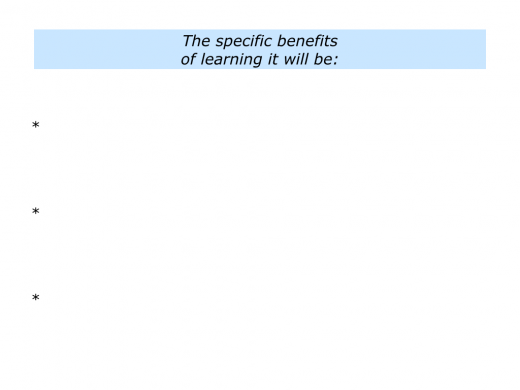




Leave a Reply